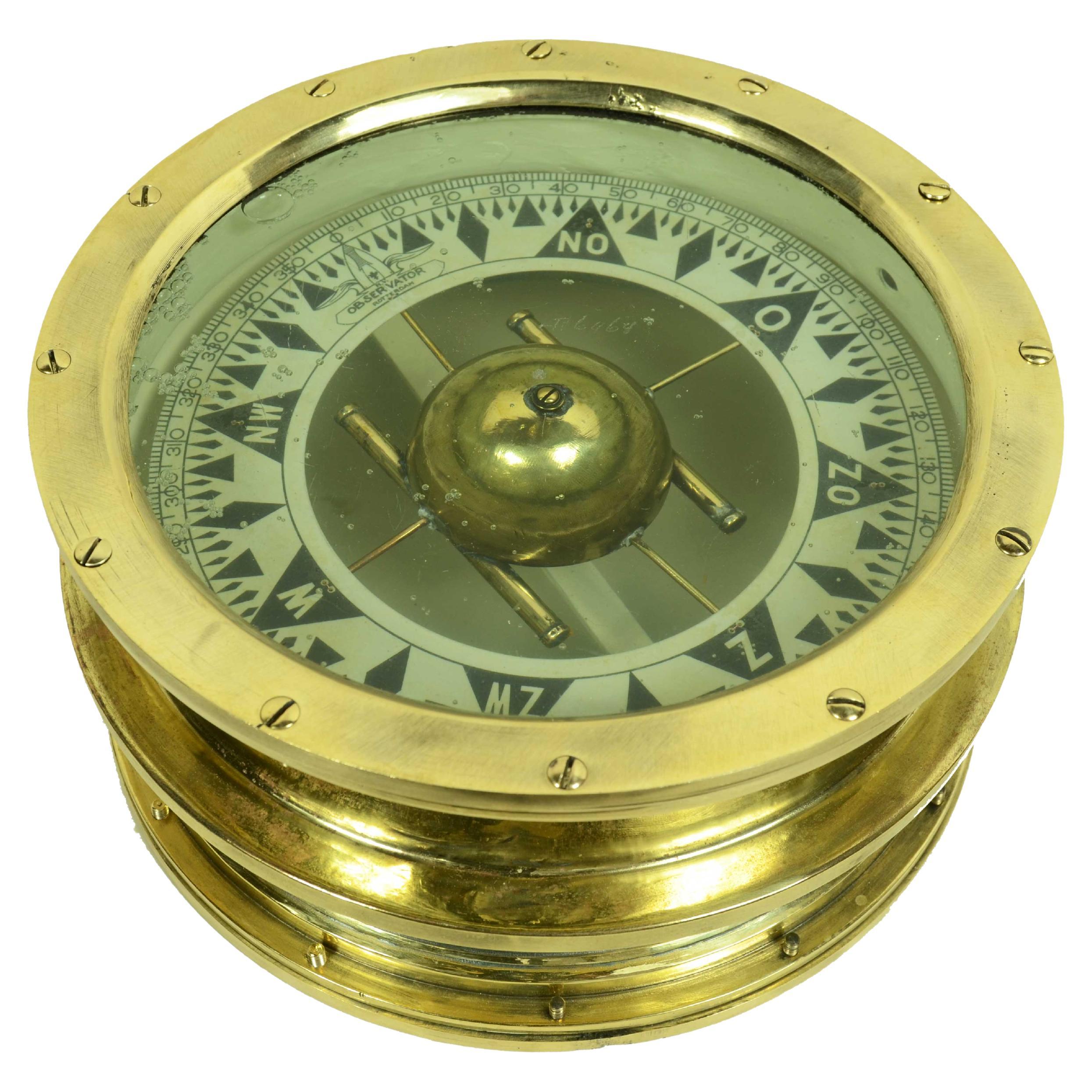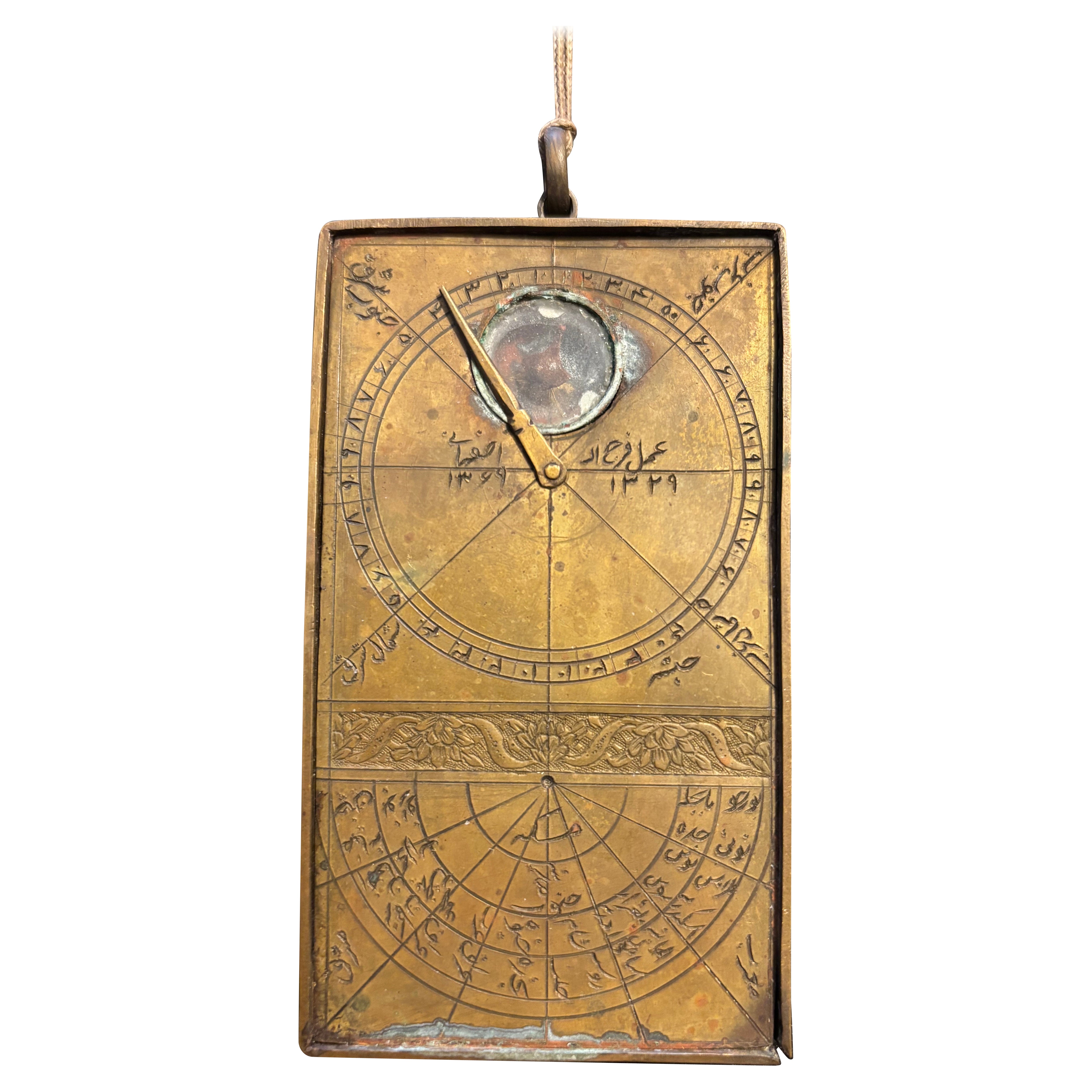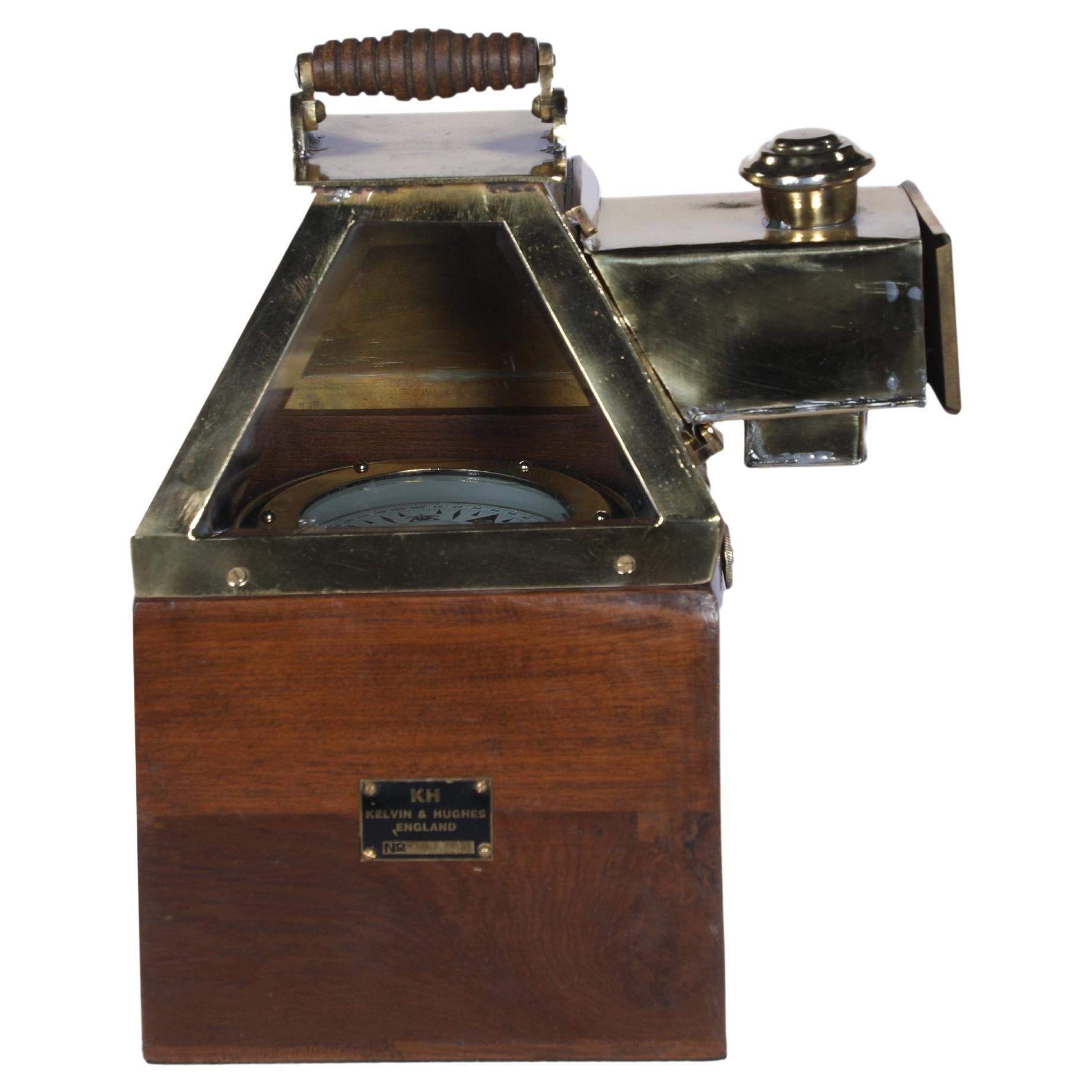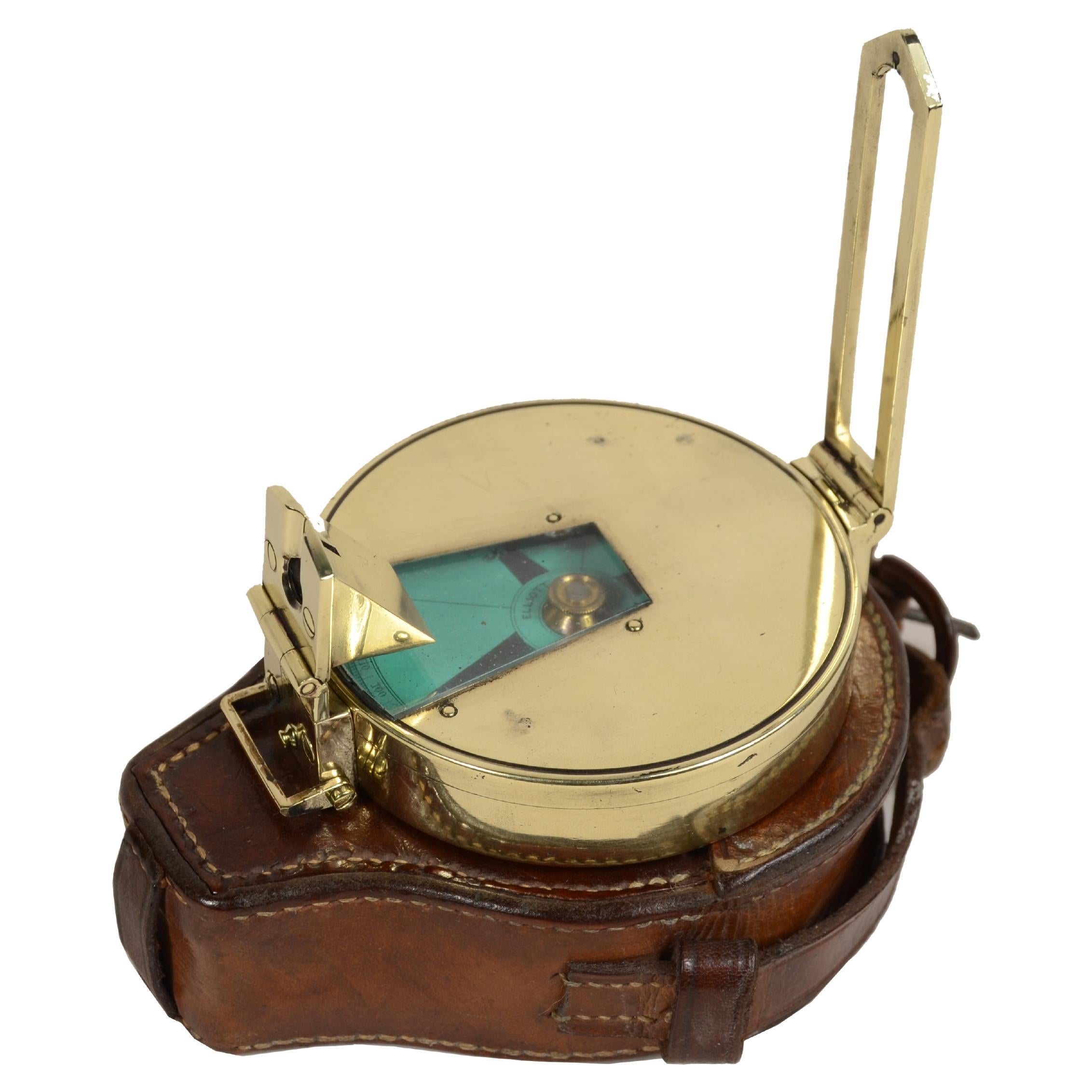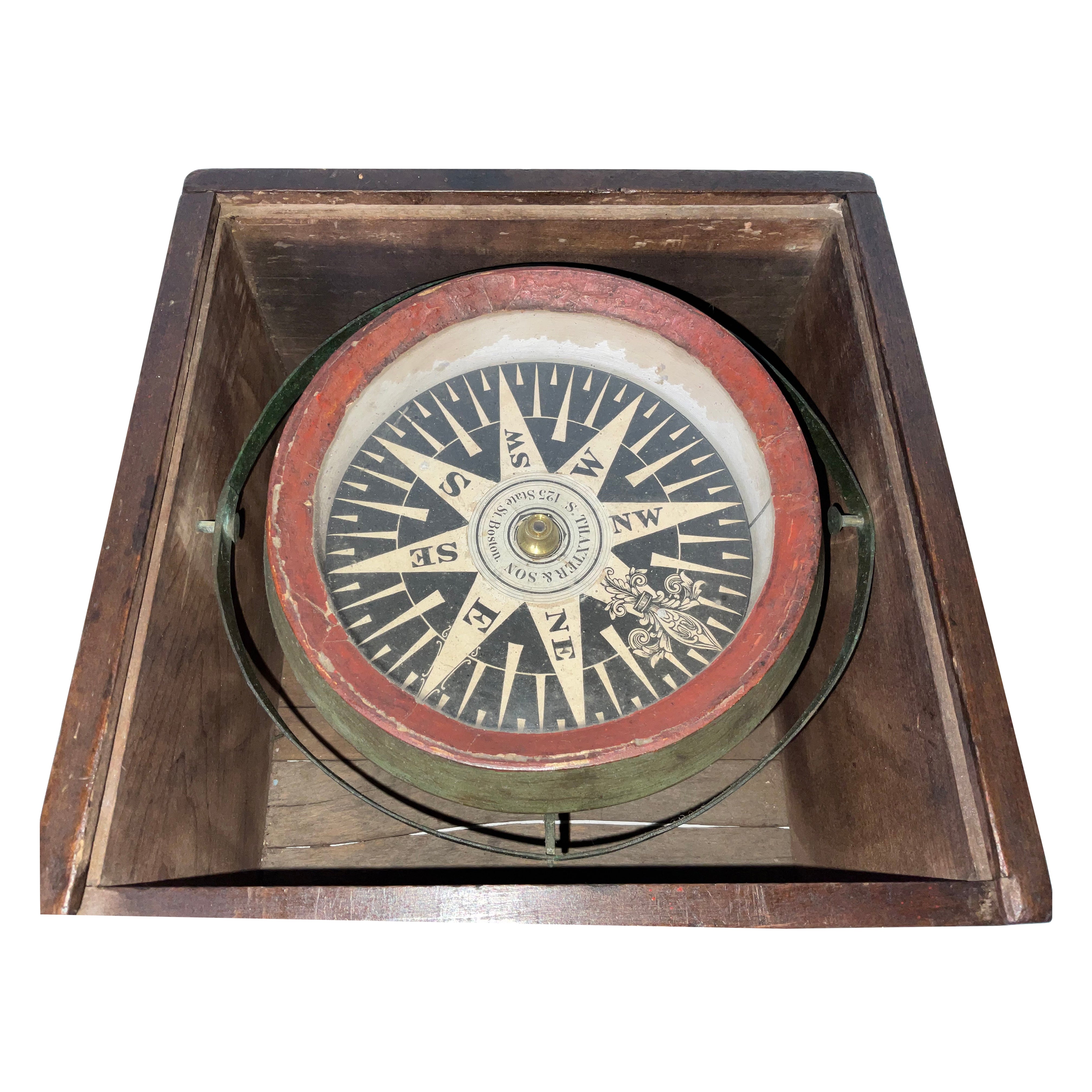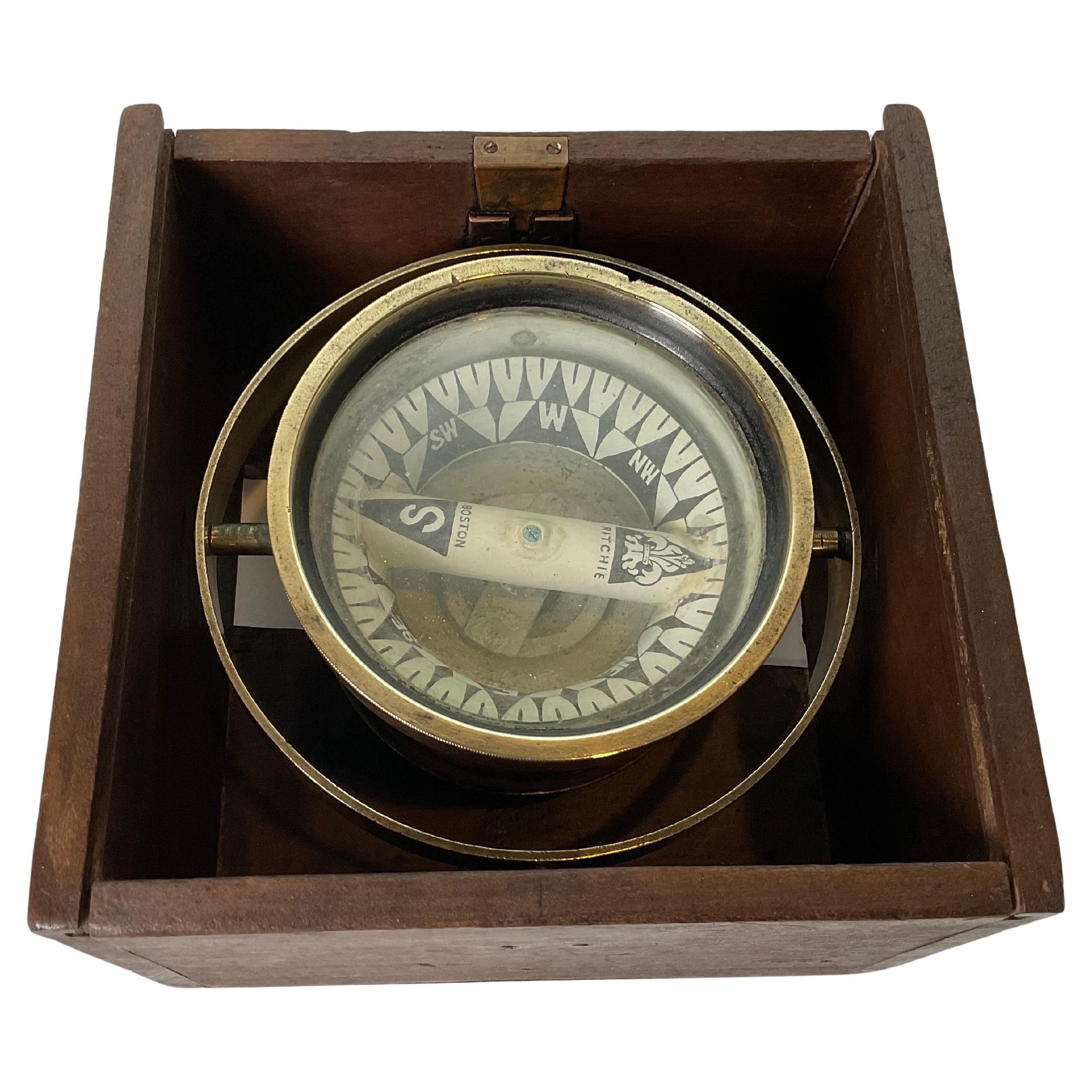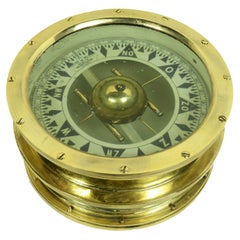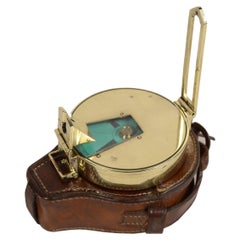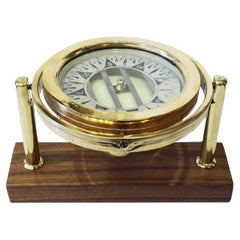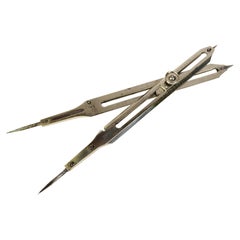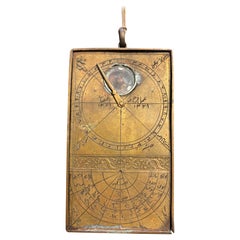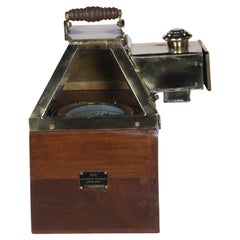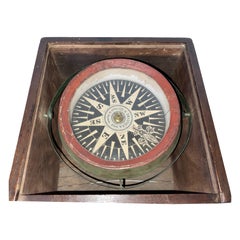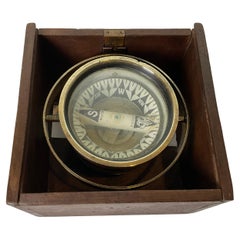Items Similar to Large late 19th century brass nautical compass signed Kelvin-White Boston-New York
Want more images or videos?
Request additional images or videos from the seller
1 of 19
Large late 19th century brass nautical compass signed Kelvin-White Boston-New York
$3,234.99
£2,407.79
€2,700
CA$4,431.12
A$4,928.38
CHF 2,573.45
MX$59,973.11
NOK 32,866.83
SEK 30,823.29
DKK 20,554.16
Shipping
Retrieving quote...The 1stDibs Promise:
Authenticity Guarantee,
Money-Back Guarantee,
24-Hour Cancellation
About the Item
Large brass and glass nautical magnetic compass, late 19th century, signed Kelvin-White Boston-New York, mounted on custom-made oak and brass board.
Measures 33x25x22 cm - inches 13x9.8x8.8, compass diameter cm 20.5 - 8.1 inches.
The last photo is the gift box.
The compass is consisting of a cylindrical-shaped brass vessel called a mortar, on which fund is attached is a hard metal stem, called the sensing element, on which rests the eight rose winds, suitably constrained, complete with goniometric circle so that zero coincides with magnetic polarity.
To minimize friction, the mortar was filled with liquid, which was intended to quickly dampen any oscillations in the complex, and closed at the top by a strong protective glass. The inside of the compass is equipped with a second 0° to 180° goniometric circle
The Greeks and the Romans were still unaware of the possibility of harnessing magnetic fields for orientation, while it seems that this possibility was already somewhat known to the Chinese: around 2600 B.C. Emperor Hoang-Ti was able to overcome Prince Tchi-Yeou in battle thanks to a "magic" chariot, the See-Nan (chariot pointing south). The emperor, thanks to this device, identified the enemy's escape route, despite the fact that the enemy had concealed it through a blanket of smoke: fixed on the chariot was a human-shaped wooden silhouette that rotated on itself and, with its arm outstretched, always pointed south (pointing south of course was also pointing north at the same time, but south was considered by the Chinese to be the most important cardinal point). The Chinese also used their discoveries related to magnetic fields as a form of entertainment and spectacle: they would throw magnetized arrows as if they were dice, and these would line up in a south-north direction as if by magic, which greatly impressed and amazed the spectators.
The earliest hints of the use in Europe of instruments that harnessed magnetic force for navigational orientation date back to the late 12th century, mainly due to the knowledge brought by Arab merchants and navigators: we find hints of this in Alexander Neckam's work "De nominibus utensilium" and in the works of Guyot de Provins in which the magnet is referred to as the "sailor's companion." The inventory of a 13th-century Sicilian ship, the San Nicolo, also mentions the presence of a magnet and a "ligno compass" on board.
The Kelvin-White company grew out of the professional relationship between William Thompson (1824-1907) professor of physics and James White (1824-1884) manufacturer of optical and surveying instruments.
Thompson designed instruments and Kelvin made them.
They contributed to the first laying of telegraph cables at sea, and their collaboration lasted until Thompson's death.
William Thompson was appointed in 1892 as Lord under the name Baron Kelvin of Largs.
In 1874 Thompson wrote an article on compasses for a magazine, this article gave a major boost to the demand for compasses and of nautical instruments.
After White's death in 1884, Kelvin continued with the business, equipping new workshops to produce precision nautical instruments, becoming an official supplier to the Admiralty, which adopted a compass patented in 1899 on Royal Navy ships.
- Dimensions:Height: 8.8 in (22.36 cm)Width: 13 in (33.02 cm)Depth: 9.8 in (24.9 cm)
- Materials and Techniques:
- Period:
- Date of Manufacture:1890
- Condition:Wear consistent with age and use.
- Seller Location:Milan, IT
- Reference Number:1stDibs: LU1020246013492
About the Seller
5.0
Vetted Professional Seller
Every seller passes strict standards for authenticity and reliability
Established in 1999
1stDibs seller since 2014
398 sales on 1stDibs
Typical response time: 1 hour
- ShippingRetrieving quote...Shipping from: Milan, Italy
- Return Policy
Authenticity Guarantee
In the unlikely event there’s an issue with an item’s authenticity, contact us within 1 year for a full refund. DetailsMoney-Back Guarantee
If your item is not as described, is damaged in transit, or does not arrive, contact us within 7 days for a full refund. Details24-Hour Cancellation
You have a 24-hour grace period in which to reconsider your purchase, with no questions asked.Vetted Professional Sellers
Our world-class sellers must adhere to strict standards for service and quality, maintaining the integrity of our listings.Price-Match Guarantee
If you find that a seller listed the same item for a lower price elsewhere, we’ll match it.Trusted Global Delivery
Our best-in-class carrier network provides specialized shipping options worldwide, including custom delivery.More From This Seller
View AllLarge brass nautical compass signed OBSERVATOR Rotterdam of the 1930s
Located in Milan, IT
Large brass liquid compass signed OBSERVATOR Rotterdam from the 1930s. Eight-twenty rose complete with goniometric circle.
Compass diameter cm 21.5 - 8.5 in, height cm 10.5 - 4.1 in...
Category
Vintage 1930s Nautical Objects
Materials
Brass
Nautical survey magnetic compass signed Elliott Bros London late 1800s
Located in Milan, IT
Rare magnetic nautical surveying compass, brass, late 19th century signed Elliott Bros London complete with leather case. This is a small compass, 7 cm diameter, typically used in re...
Category
Antique Late 19th Century Nautical Objects
Materials
Brass
Brass nautical compass signed DIRIGO Eugen M. Sherman Seattle USA 1920
Located in Milan, IT
Nautical compass on gimbal signed DIRIGO Eugen M. Sherman Seattle USA 1920s, mounted on custom-made walnut and brass board. Eight-twenty rose complete with protractor circle. The com...
Category
Vintage 1920s Nautical Objects
Materials
Brass
19th Century English Chrome Plated Brass Cross-Legged Reduction Compass
Located in Milan, IT
Cross-legged reduction compass, of chrome plated brass and steel, English manufacture from the end of the 19th century.
Fixed or mobile center, whose opposite points form simple re...
Category
Antique 1890s Scientific Instruments
Materials
Brass
The Magnapole 1920s brass nautical travel surveying compass
Located in Milan, IT
Brass travel nautical surveying compass circa 1920, complete with original leather case, signed The Magnapole Patent 22598.
Small compass used away from magnetic fields to verify the...
Category
Vintage 1920s Nautical Objects
Materials
Brass
End 19th Century Antique Magnetic Topographic Compass Made in Brass and Oak
Located in Milan, IT
Magnetic topographic compass, of oak and brass; instrument consisting of a magnetized needle free to rotate on a horizontal plane, marking with the tip of the needle the direction of magnetic north, compass card with eight winds complete with goniometric circle divided into 360 °, complete with the compass needle lock. Italian manufacture of the late 19th century. Very good condition. Measure 3.1x3.1 height 1.
Shipping is insured by Lloyd's London; our gift box is free (look at the last picture).
The invention of the compass is mysterious but it is well known that magnetite was discovered in Magnesia, a city of Asia Minor. We can find the first indications about the use in Europe of the magnetic force for orientation at the end of the XII century...
Category
Antique 1890s Italian Scientific Instruments
Materials
Oak
You May Also Like
19th Century Indian Brass Qibla Compass
Located in Stamford, CT
19th Century Indian etched brass Qibla compass.
The compass with brass needle and glass cover, the reverse engraved with tables.
4.2 inches high 2.3 wide
A qibla (qiblah) compa...
Category
Antique Late 19th Century Indian Anglo-Indian Scientific Instruments
Materials
Brass
Rare Kelvin and Hughes Teak and Brass Navigational Nautical Binnacle Compass
Located in Nantucket, MA
A rare ship's binnacle brass compass in working order housed in a teak and brass case. It includes the kerosene side light to illuminate the compass at night. By Kelvin and Hughes,...
Category
Mid-20th Century Mid-Century Modern Nautical Objects
Materials
Brass
19th Century Wood Bowl Ship's Compass by Samuel Thaxter of Boston
Located in Norwell, MA
Early nineteenth-century wood bowl ship's compass by Samuel Thaxter & Son of 125 State Street, Boston. With strap gimbal and is fitted to a dovetailed timber box with its original li...
Category
Antique 1850s North American Nautical Objects
Materials
Brass
19th Century Dry Card Compass by Ritchie of Boston Dated 1863
Located in Norwell, MA
Quality ship's compass from Boston maker E.S. Ritchie. Heavy brass bowl is engraved with the maker's name and patent dates: Sept. 9, 1862, and Apr. 7, 1863, with a cylindrical compas...
Category
Antique 1860s North American Nautical Objects
Materials
Brass
Early 19th century brass surveyor's level with compass
Located in London, GB
An early 19th century brass surveyor's level with telescope, compass and spirit level.
With original brass mounted pine case.
Telescope length: 18 1/4 inches. - 46.5 cm.
Fitting for tripod mount, now re-mounted on a modern brass plate for desk top display.
Category
Antique Early 19th Century English Scientific Instruments
Materials
Brass
$1,205 Sale Price
20% Off
Teak and Brass Ships Binnacle by Kelvin White of New York
Located in Norwell, MA
Five brasses have been meticulously polished and lacquered. Warm Lighting has been installed inside. A lantern housing is fitted to the hood. Brass bolts a...
Category
Vintage 1940s North American Nautical Objects
Materials
Brass
More Ways To Browse
Stanley Telescope
Vintage Planimeter
Negretti & Zambra On Sale
Chadburns Telegraph
Vintage Anemometers
Fuji Binocular
Deep Sea Diving Helmet
Harpoon Gun
Tuiga 1909
Japanese Glass Fishing Floats
John Hastie Co
John Hastie Greenock Ships Wheel
Grog Tub
Scrimshaw Game
Shark Vertebrae
Antique Microscope Wooden Box
Antique Marine Binoculars
Brass Bollards
